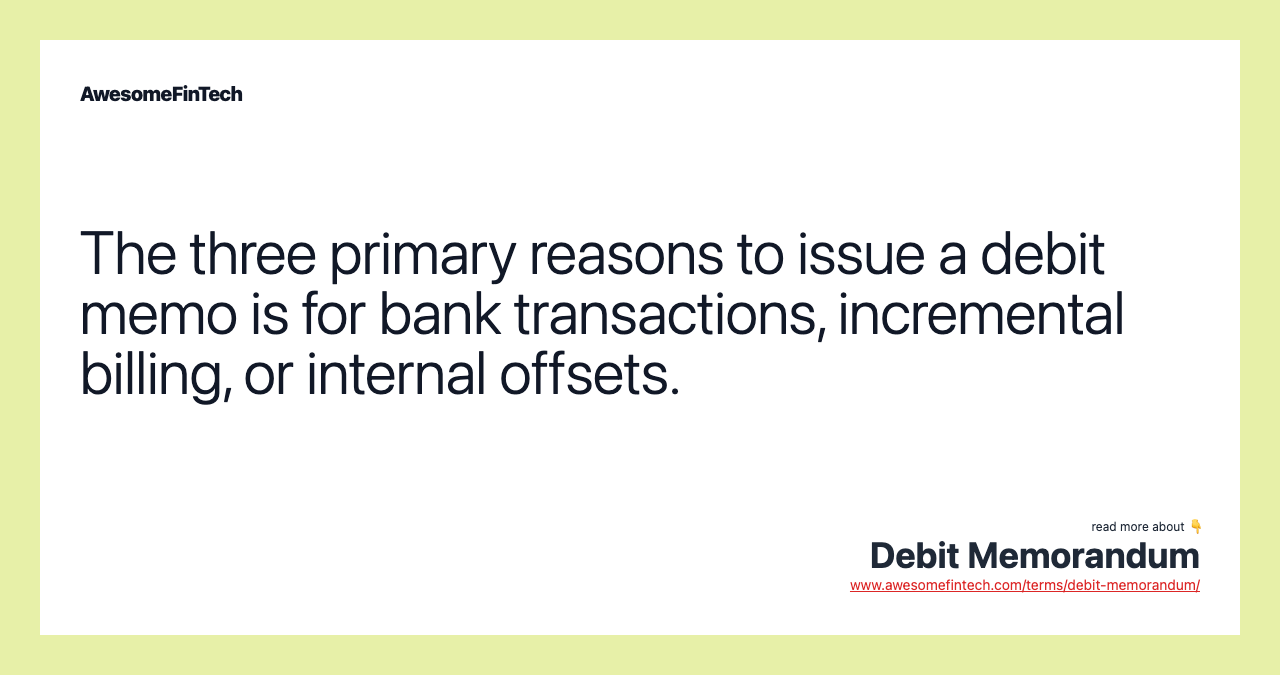Debit Memorandum
A debit memorandum, or "debit memo," is a document that records and notifies a customer of debit adjustments made to their individual bank account. A debit memo is issued for three general cases: a reduction in a bank customer's account balance due to fees and other related charges, under-billing of goods or services from a seller to a buyer, or an internal offset to a minor credit balance in a customer account. In retail banking, a debit memorandum is given to an account holder indicating that an account balance has been decreased as a result of a reason other than a cash withdrawal, a cashed check, or use of a debit card. A debit memorandum is a notification to a customer that a debit adjustment has been made to their account, reducing the value of funds available. For instance, if ABC Co. fills an order for XYZ Inc. and invoices the customer in an amount that is short of the agreed amount, ABC Co. will issue a debit memo to XYZ Inc. to indicate and explain the balance due.

What Is a Debit Memorandum?
A debit memorandum, or "debit memo," is a document that records and notifies a customer of debit adjustments made to their individual bank account. The adjustments made to the account reduce the funds in the account but are made for specific purposes and used only for adjustments outside of any normal debits. The reasons a debit memorandum would be issued relate to bank fees, undercharged invoices, or rectifying accidental positive balances in an account. The opposite of a debit memorandum is a credit memorandum.




Understanding a Debit Memorandum
A debit memo is issued for three general cases: a reduction in a bank customer's account balance due to fees and other related charges, under-billing of goods or services from a seller to a buyer, or an internal offset to a minor credit balance in a customer account. These types of situations are typically referred to as bank transactions, incremental billing, and internal offsets, respectively.
Bank Transactions
In retail banking, a debit memorandum is given to an account holder indicating that an account balance has been decreased as a result of a reason other than a cash withdrawal, a cashed check, or use of a debit card. Debit memos can arise as a result of bank service charges, bounced check fees, or charges for printing more checks. The memos are typically sent out to bank customers along with their monthly bank statements and the debit memorandum is noted by a negative sign next to the charge.
Incremental Billing
In business-to-business transactions, a debit memo is issued as an adjustment procedure following an inadvertent under-billing of goods or services provided to a customer. It is intended to correct a billing error. In formal parlance, it is notifying a customer that the debit memorandum will be increasing their accounts payable. For instance, if ABC Co. fills an order for XYZ Inc. and invoices the customer in an amount that is short of the agreed amount, ABC Co. will issue a debit memo to XYZ Inc. to indicate and explain the balance due.
Internal Offset
Within a firm, a debit memo can be created to offset a credit balance that exists in a customer account. If a customer pays more than an invoiced amount, intentionally or not, the firm can choose to issue a debit memo to offset the credit to eliminate the positive balance. If the credit balance is considered material, the company would most likely issue a refund to the customer instead of creating a debit memo.
Related terms:
Accounts Payable (AP)
"Accounts payable" (AP) refers to an account within the general ledger representing a company's obligation to pay off a short-term debt to its creditors or suppliers. read more
Accrued Revenue
Accrued revenue—an asset on the balance sheet—is revenue that has been earned but for which no cash has been received. read more
Bad Debt
Bad debt is an expense that a business incurs once the repayment of credit previously extended to a customer is estimated to be uncollectible. read more
Bank Fees
Bank fees are nominal fees for a variety of account set-up and maintenance, and minor transactional services for retail and business customers. read more
Bounced Check
A bounced check is slang for a check that cannot be processed because the writer has insufficient funds. read more
Checking Account
A checking account is a deposit account held at a financial institution that allows deposits and withdrawals. Checking accounts are very liquid and can be accessed using checks, automated teller machines, and electronic debits, among other methods. read more
Debit
A debit is an accounting entry that results in either an increase in assets or a decrease in liabilities on a company's balance sheet. read more
Disbursement
Disbursement is the act of paying out or disbursing money, which can include money paid out for a loan, to run a business, or as dividend payments. read more
Petty Cash
Petty cash is a small amount of cash on hand used for paying expenses too small to merit writing a check. Learn how to balance petty cash in accounting. read more
Retail Banking
Retail banking consists of basic financial services, such as checking and savings accounts, sold to the general public via local branches. read more